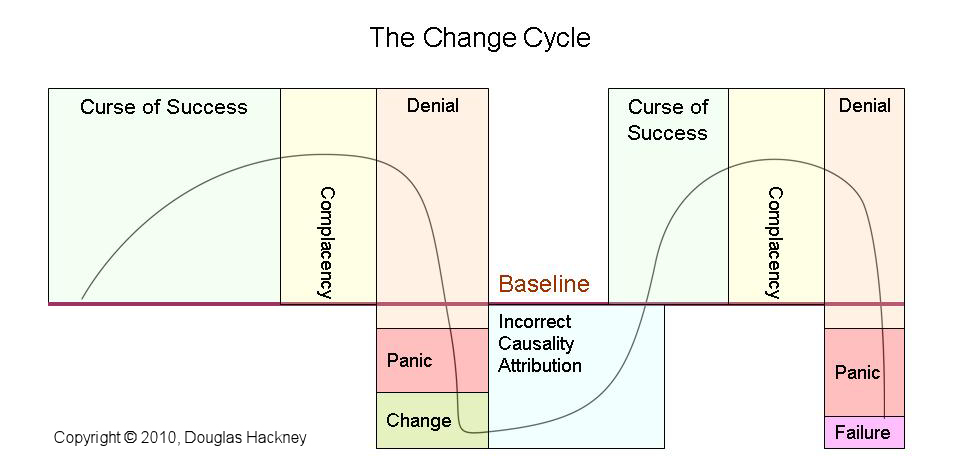More than 9 out of 10 patients do not change their lifestyles in response to their doctor’s recommendations.
More than 70 percent of corporate change efforts fail.
Humans hate change.
It’s a simple fact of life. There isn’t any easy way around it. In general, humans hate change.
That rule extends beyond individuals into groups of humans: families, tribes, organizations, companies, communities and nations. Humans hate change.
As individuals and groups, we tend to get locked into a way of doing things, a set of perceptions and a set of expectations. Anything that forces us to change anything about what we consider normal is usually resisted.
Even in the face of overwhelming evidence for the need for change, we will resist change. For example, the majority of people who suffer heart attacks do not make long term changes in their lifestyles to eliminate or limit factors that contribute to heart disease. In other words, even when it’s a matter of life and death, humans hate change so much they won’t change even to save their own lives.
There are university degree programs in change management; multiple national and global professional associations of practicing change management consultants; countless thousands of trained, certified and degreed change management practitioners and a cornucopia of books, videos, workshops and tutorials on implementing change. In spite of all this learning and all these resources, there has been relatively little improvement in change rates in humans or groups of humans.
Why is this so?

The reason humans and groups of humans are so poor at making changes is that there is actually a very small window of opportunity for change in humans and groups of humans.
Most people and organizations consider themselves open to change. You could not begin to count the number of leaders who promote a culture of openness to change and constant improvement. Although this makes for good public relations, in reality, humans and groups of humans are typically open to and accepting of change only during a very small portion of time relative to their overall existence.
(click for larger image)
The lifecycle of humans and groups of humans, such as companies and countries, consists of cycles, cyclic periods of relative growth and shrinkage. During these cycles, humans and groups of humans such as companies and countries spend most of their time blocked off from being open to and accepting of change.
During growth periods, humans, companies and countries are in the cocoon of the Curse of Success. Everything is going great, so there is no need to be open to any external inputs, regardless of source. It is useless to attempt to provide advice, guidance or predictions of future challenges to humans, companies or countries during this period. From their perspective, they are succeeding, so they have no need of improvement; they are obviously the single and sole source of their success, so others have nothing to offer that could possibly be of value to them.
When growth slows, complacency sets in. Humans, companies and countries consider this a brief lull before inevitable growth returns. They use this period to relax and recover from the exertions of the high growth period. Again, it is useless to attempt to provide any suggestions for improvements or warnings of coming challenges during this period. From their point of view, they just had a huge run of success. If anyone should be offering advice, it is they who should be instructing others; their success had nothing to do with external factors or the overall environment; success was due to their unique combination of talents and abilities.
When things turn downward, humans, companies and countries engage in a long period of denial. During this period they attempt to apply solutions to past problems to the new challenges they face. They will continue to cycle through previous solutions to past problems until they pass through the baseline. Only then will they consider the possibility that they are facing new challenges that their old solutions won’t overcome.
Once they are well and truly lower than the baseline where they started, they will panic and desperately apply any possible solution in an effort to return to the sweet days of growth and the lazy afternoons of complacency. This period is when individuals, companies and countries attempt “silver bullet” solutions, magic cures and radical reorganizations, often leading to outright failure. This period is a fertile market for purveyors of quackery, flim-flam artists, con men and get-rich-quick schemes on the individual and small group level and seemingly simple solutions to complex problems at the large group to country scale.
If they survive the panic phase, they will finally, albeit briefly, be open to and accepting of real change.
Real change requires real work. It requires real changes in processes, perceptions, activities, structures and organization. As such, humans and groups of humans attempt to limit the amount of real change as much as possible. During this period, they are enthusiastic about the concepts of change, but very resistant to fully adopting and implementing the nuts-and-bolts reality of complete change. If they succeed in not fully changing, they guarantee that they will revisit the downward slope and panic phase shortly.
As soon as humans and groups of humans sense a shift in direction from plunging ever downward to leveling out, change stops. Lip service, platitudes and posters regarding change may still linger, but real change, complete change, ceases immediately.
The next step in the cycle is incorrect attribution of causality. For individuals or groups that survive the terrifying dive to near oblivion only to pull up just as they were staring directly at disaster, the only possible cause of their success is themselves. They immediately begin the process of self-congratulation and self-reinforcement of all the things they did right to save themselves. As they begin to experience growth, this loop becomes self-enabling, self-certifying and self-accelerating. The more they experience success, the more entrenched the legends of how they survived and triumphed over adversity become. The long drop off the cliff, the panic, the terror all fade into dim memories as they pass upward through the baseline and wall themselves off in the cocoon of the Curse of Success.
And the cycle begins anew.
As you can see, the window of opportunity, the period of time, when people are open to and accepting of change is actually extremely limited. That is the reason why humans and groups of humans are so miserable at effecting change in their lives, their tribes, their communities, their companies and their countries.
Where are you in this cycle?
Where is your tribe, your community and your company in this cycle?
And, of critical importance right now, where is your country in this cycle?
*******
Sources:
- Texas A&M University
- Harvard Business Review
- Canadian Medical Association
- Enterprise Group, Ltd. www.egltd.com



